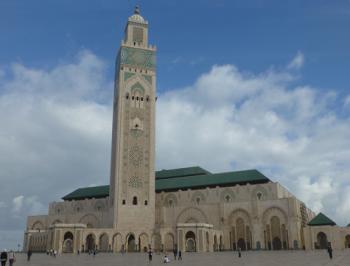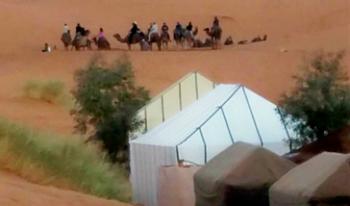Morocco in depth (Second of three parts)
This item appears on page 40 of the August 2019 issue.
On my 18-day, April 2019, hosted group tour to Morocco with the small-group adventure-tour operator (and ITN advertiser) ElderTreks, we simply covered a lot more ground than most shorter itineraries do.
My travel writer/tour leader/tour operator genes compel me to automatically assess a tour in terms of what I thought was good to great and also what might be improved or changed.
What I particularly appreciated regarding this in-depth Morocco itinerary was the pace of the tour. While it was fast-moving in terms of more single-night than 2-night stops, this was necessary in order to include all of the destinations visited.
Additionally, the tour pace was evened a lot by not having early-morning departures, as is often a constant with shorter group itineraries.
The tour I took, “Morocco – Kasbahs, Berbers & the Sahara,” operates only twice a year, in April and October, so sometimes the standards of a hotel or an attraction can decrease or improve between tours.
In our case, our guide advised me that two of the 12 hotels on our tour had slipped a bit in terms of quality and service. I have since learned that they are being replaced for the next departure in April of 2020.
A property new to the tour was a beautiful, 5-star, French-villa-style compound, Dar al Hossoun, in Taroudant. We were hosted by its entrepreneurial owner/developer, who gave us an educational behind-the-scenes tour of the compound grounds, including the exquisite gardens and some surrounding properties.
Information gathering
As a working traveler, I tend to be an information junkie while on tour. I want to know in some detail how things work on the ground in each destination being visited. This includes the topics of politics, education, the economy, cost of living, employment, health care, etc.
While it is important to know where a country has been historically, for me it is of even greater importance to formulate a picture of where it is at present and where it seems to be headed.
While at times I had to make an extra effort to extract all the detail I required, our very knowledgeable Moroccan guide, Samir Harit, was always forthcoming.
Also, his guide radar was exemplary. I marveled at his ability to keep track of our group members while navigating the maze of narrow walkways in the crowded souks within the ancient medinas in many of the cities we visited. At times, his not losing anybody seemed miraculous.
Casablanca to Fez
Last month, I outlined our tour’s circuitous journey around Morocco. This month, I’d like to share some of the highlights from the first part of our journey.
The primary reason to visit Casablanca, other than its being Morocco’s largest city and the main air-entry point for international visitors, is to see the massive, awe-inspiring, waterfront Hassan II Mosque, which was completed in 1993 and is the largest mosque in Africa. At 210 meters tall, its minaret was the world’s tallest until recently losing that title to a mosque under construction in Algiers in neighboring Algeria.
Our guided tour of the Hassan II Mosque with Samir revealed a venue of staggering opulence, where up to 25,000 souls can simultaneously worship indoors. It’s a must-visit site.
Our group thoroughly enjoyed the in-depth walking tour of the Roman ruins of ancient Volubilis, as Samir painted a detailed picture of its fascinating history. For me, a part of its allure is that it resides in what is now a pastoral, serene setting far removed from modern-day civilization.
Meknes became the capital of the land under the rule of Moulay Ismail, the second Alaouite sultan, who must have been a closet architect, as attested to by the enormous palace complex constructed during his reign (1672-1727). This included some 25 miles of utterly imposing walls featuring ornate gates. The remaining construction continues to impress visitors today.
Ancient Fez featured a souk (market) that would be a “must” film set for the next Indiana Jones sequel. Its colorful, endless maze of winding narrow alleys, where donkeys enjoyed the right of way, was surreal.
Later, from a terrace, we looked out over the huge vats of Fez’s leather tanneries, exposing our lenses to every hue of the rainbow and our nostrils to less-pleasing sensations.
Middle Atlas to Sahara
Heading southward into the Middle Atlas Mountains, we encountered beautiful cedar forests and thoroughly enjoyed a rest break for cappuccino and wonderful French pastries in picture-perfect Ifrane.
This pristine mountain village seemed like a Swiss Alps ski resort movie set for a James Bond movie and was a remarkable contrast to what we had experienced of Morocco up to that point. It will be impossible for me to forget the cool, pure mountain air infused with the waft of fresh-from-the-oven croissants.
Winding southward through the mountains, we arrived in the small village of Erfoud, a gateway to the Sahara. There we saw the petrified remains of fossils being slab mined under government control to produce everything from jewelry to furniture. Unique fossil souvenirs were on offer, and I was unable to resist acquiring a few.
In Merzouga, we mounted up for our eagerly anticipated camel safari to a Berber tented camp for an overnight in the Sahara. The trek provided excellent photo ops and allowed us to understand why, even today, camels remain the vehicle of both choice and necessity in some dune environments.
Enjoying the inspiring sunset and sunrise from dunes at the edge of our camp, it was apparent that we were not alone. There were several tented camps cleverly placed among the dunes but, thankfully, removed enough from each other to ensure soundproofing.
The experience was quite enjoyable although not as remote and isolated as I had wished, as this experience is extremely popular with visitors. Personally, I was sad to see Wi-Fi installed in the main dining/meeting tent and was relieved to learn it was not operational. If we cannot escape it there, then where?
Departing our tented camp by 4-wheel-drive, we raced across the barren desert flats, stopping to visit the mobile tented camp of a nomad family. We were able to get up close and personal with the nomadic lifestyle they still prefer and somehow manage in today’s world. For these nomads, the sun comes up and goes down, but, otherwise, time seems joyously mute.
By this time, I was finally allowing all of the incredible stimuli to which we were being exposed to flow into my consciousness unfiltered. For some of us, travel to very foreign lands seems to be our truest salvation.
Next month, I’ll share additional highlights of our journey through Morocco plus recommendations for visiting this diverse land of mystery. For more info, contact ElderTreks (Toronto, ON; 800/741-7956, www.eldertreks.com).
Contact Randy at 80 America Way, Jamestown, RI 02835; 401/560-0350, randykeck@yahoo.com.



